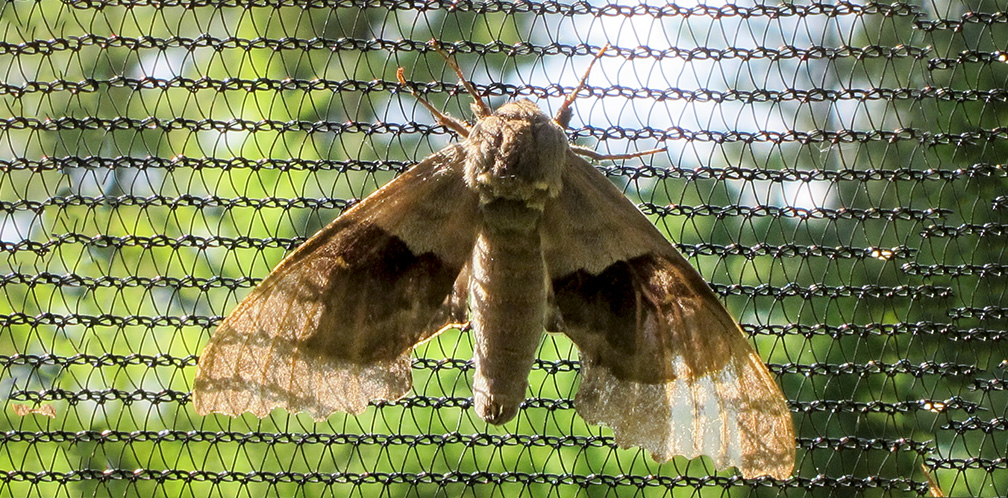Butterflies & Moths of the Adirondacks:
Modest Sphinx (Pachysphinx modesta)

The Modest Sphinx (Pachysphinx modesta) is a large moth that may be seen in the Adirondack Mountains of upstate New York in late spring and early summer. It is a member of the Sphingidae family. [1] This family includes about one thousand species of heavy-bodied moths with strong wings. [2] The species name of the Modest Sphinx (Modesta) derives from the fact that the bottom half of the moth, when seen facing up on a wall, is dark, as if covered in modesty by a shawl. [3] This moth is also known as the Big Poplar Sphinx – a reference to one of its preferred host plants. [4] [5] This is a nocturnal moth which readily comes to light. [6]
The Modest Sphinx can be recognized by its large size and the scalloped outer margin of its long narrow fore wings. [7] The upper side of the fore wing is gray-brown with a dark median band. [8] The upper side of the hind wing is also gray-brown with a deep crimson patch. [9] [10] This moth has a wing span of 3 to 4 11/16 inches. [11]
Female Modest Sphinx moths extend a scent gland from their abdomen to lure the night-flying males. [12] The females lay their eggs of the leaves of host plants, which include poplar, aspen, cottonwood, and willow. [13] [14] The eggs, which are large and a translucent pale green in color, hatch is about nine days. [15] [16] The eggs later turn a shiny bronze in color. [17] The caterpillar is usually pale green. [18] Caterpillars pupate and spend the winter in shallow burrows in the ground. [19] [20] [21] Adults do not feed. [22]
The range of the Modest Sphinx covers much of North America, from Maine and the southern portions of all Canadian provinces south to northern Florida and west to Washington, Oregon, New Mexico, and Texas. [23] [24] [25] The flight period of the Modest Sphinx in the northeastern parts of North America is from late spring to early summer. [26]
The flight period for this moth in the Adirondack Park has not been documented, but appears to extend from early June to early July. In 2012, the Modest Sphinx was seen in the Paul Smiths VIC Native Species Butterfly House in early June. In 2013, the Modest Sphinx was present in the Butterfly House in early July. [27] Modest Sphinx moths were observed in Fulton County in early July 2011, in Hamilton County in early July 2008, and in Fulton County in June 2016. [27]
References
- Susan Grimm Hanley. Interpretive Naturalist, Paul Smith's College Native Species Butterfly House. Species Logbooks.
- Butterflies and Moths of North American. Species Profiles. Sighting records: 6/1/2011, 7/2/2011, 5/28/2012, 6/9/2012, 6/3/2016.
- Iowa State University. Department of Entomology. BugGuide.
- Insect Images. Modest Sphinx.
- Sphingidae of the United States. Pachysphinx modesta.
- Discover Life. Pachysphinx modesta.
- Mississippi State University. Mississippi Entomological Museum. North American Photographers Group. Pachysphinx modesta.
- University of Alberta. Department of Biological Sciences. E.H. Strickland Entomological Museum. Pachysphinx modesta.
- World Field Guide. Pachysphinx modesta.
- Charles V. Covell, Jr. A Field Guide to the Moths of Eastern North America (Houghton Mifflin Company, 1984), p. 38, Plate 3.
- David Beadle and Seabrooke Leckie. Peterson Field Guide to Moths of Northeastern North America (Houghton Mifflin Harcourt Publishing Company, 2012), pp. 264-265.
